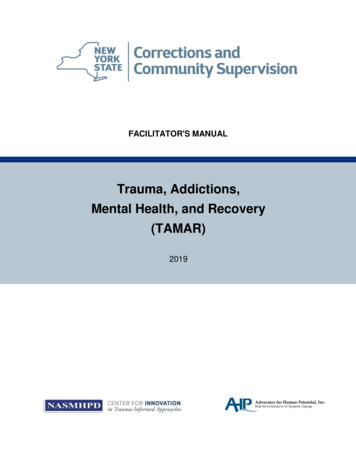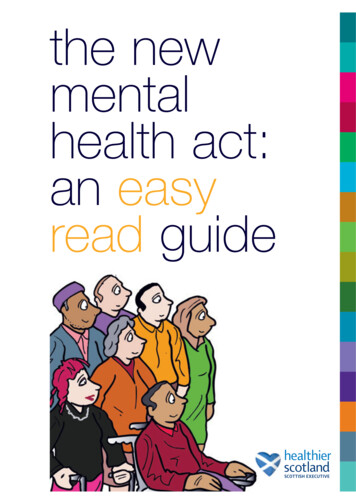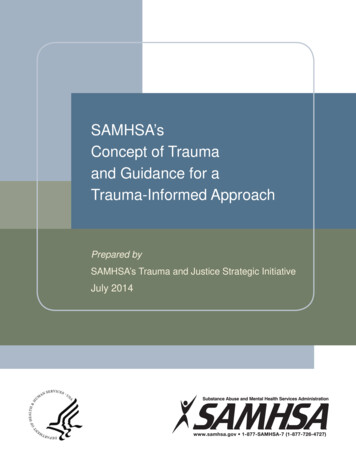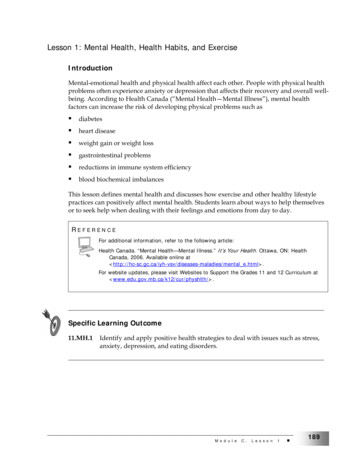
Transcription
FACILITATOR'S MANUALTrauma, Addictions,Mental Health, and Recovery(TAMAR)2019
NYS DOCCS TAMAR
AcknowledgementsThe New York State Department of Corrections and Community Supervision (NYS DOCCS) wouldlike to thank all who spearheaded this trauma-specific group intervention model andcollaborated with the National Association of State Mental Health Program Directors(NASMHPD) Center for Innovation in Trauma-Informed Approaches and Advocates for HumanPotential, Inc. (AHP) to design a trauma-specific intervention for individuals incarcerated in NYScorrectional facilities. Trauma, Addictions, Mental Health, and Recovery (TAMAR) was originallydeveloped in 1999 as part of a Substance Abuse and Mental Health Services Administration(SAMHSA) Women and Violence project site in Maryland. This version was adapted from theoriginal TAMAR model by Leah Harris, M.A. (NASMHPD); Kay Peavey, B.A. (AHP); Joan Gillece,Ph.D. (NASMHPD); and Pam Rainer, M.S.W. (AHP).NYS DOCCS TAMAR
NYS DOCCS TAMAR
ContentsINTRODUCTION . 1Welcome . 1Rationale . 1TAMAR Background . 1Background for Facilitators . 1Shame and Forgiveness . 2Creative Expression . 3Mind-body Skills Practice . 3TAMAR Intake/Assessment. 4Contents . 4Creating a Trauma-informed Learning Environment. 6Time Management . 6Module 1: Introduction to TAMAR . 7Module 2: The Effects of Trauma . 20Module 3: Trauma Reminders . 30Module 4: Self-soothing . 37Module 5: Tolerating Distress . 43Module 6: Containment I . 55Module 7: Containment II . 68Module 8: Physical and Emotional Abuse . 82Module 9: Sexual Abuse (Females) . 89Module 9: Sexual Abuse (Males) . 92Module 10: Trauma and Addiction. 100Module 11: Boundaries and Safety . 106Module 12: Intimacy and Trust . 116Module 13: Sexual Communication, Negotiation, and Consent . 123Module 14: Parenting . 131Module 15: Closing Ritual . 133NYS DOCCS TAMAR
NYS DOCCS TAMAR
INTRODUCTIONWelcomeCongratulations! By becoming a facilitator of Trauma, Addictions, Mental Health, and Recovery(TAMAR), you will play an essential role in helping justice-involved individuals understand theimpact of trauma on their lives, their families, and their communities, which will help themdevelop vital skills for life within and outside of the correctional facility. Recognizing trauma asa major factor in behavior can also help make your job duties easier, the correctional facilitysafer, and programming more effective. This manual provides everything you need to facilitatesuccessful TAMAR groups.RationaleFor many people involved in the justice system, trauma has shaped their experience of theworld in devastating and persistent ways. Research indicates that at least two-thirds of menand almost all women who are presently or formerly incarcerated have experienced some formof trauma, including adverse childhood experiences; emotional, physical, and/or sexual abuse;domestic violence; extreme poverty; and loss of friends and loved ones due to communityviolence. Scientific literature indicates that early exposure to trauma and violence results inchanges to the brain that can severely impact behavior.It is also important to recognize that incarceration, in and of itself, can be a highly stressful andpotentially traumatic experience.TAMAR BackgroundTAMAR was developed in the late 1990s as part of a federally funded, gender-specific programfor incarcerated women in Maryland. It has since been implemented in multiple justice andbehavioral health systems across the country. The original TAMAR intervention was customizedfor NYS DOCCS to create a clinical intervention that combines psychoeducation about traumaand its impact with concrete techniques designed to help participants of any gender identifytheir triggers and learn and practice skills for self-regulating trauma symptoms.Background for FacilitatorsNone of us is protected from misfortune, be it a one-time catastrophic event or a long-termhardship. We may be directly involved with illness, violent crime, natural disaster, divorce,accidents, abuse, domestic violence, or war. We might also encounter these eventssecondhand. Whether directly or indirectly experienced, these types of incidents can betraumatic.NYS DOCCS TAMAR1
What is traumatic for one person may be only stressful for another. Many factors contribute tothe impact of trauma: age, social and cultural influences, history of previous trauma, physicaland psychological health, and quality of coping skills. Support systems available at the time ofthe trauma and afterwards play a substantial role in how we cope. To deny pain in our lives is towalk a dangerous path that can lead to lifelong dysfunction.The aftereffects of trauma are both psychological and physiological. Feelings of helplessnessand hopelessness contribute to changes in self-image and contaminate interpersonalrelationships. Emotional flooding and numbing, chaotic and conflicted thought processes, andmaladaptive behaviors are symptoms related to being overwhelmed by trauma.Sleep disturbances, phobias, flashbacks, memory impairment, hypervigilance, physical pain, andaddictions are other debilitating symptoms that can be related to post-traumatic stress.Regardless of the cause or origin of the trauma, adults are responsible for developing thenecessary coping skills to move forward. With careful thought and daily practice, most peoplecan recover a sense of safety and purpose in their lives; some will achieve even more effectiveand beneficial ways of functioning in the world than those they used before the trauma.To overcome the impact of traumatic stress one needs to restore, or develop, healthy ways totolerate distress and pain, to exhibit compassion and respect for oneself, to interact with otherswithout compromising personal values and beliefs, and to make changes that allow for purposeand meaning in life. Creativity, a natural human function, plays an important role in thedevelopment of these abilities. TAMAR offers an opportunity to everyone, regardless ofprevious experience or artistic talent, to manage symptoms of traumatic stress in a creative,life-affirming way.Shame and ForgivenessShame is often a core feature of trauma. With no awareness of how trauma impacts the mindand body, survivors may not understand why they react the way they do in the face of stressfulor triggering events. They may feel great shame afterwards for their reactions, or they may feel“out of control” or “crazy.” TAMAR modules de-stigmatize and de-pathologize the traumaresponse by explaining to participants how their brains and bodies respond to stress andtrauma, helping them identify and understand their own unique ways of reacting understressful or traumatic circumstances, and emphasizing the possibility of change through selfregulation strategies. With this approach, participants can understand why they responded asthey did while still accepting responsibility for their actions. They can begin to forgivethemselves and can gain more of a sense of control and mastery over their emotional andphysiological responses to stressful events and triggering stimuli.NYS DOCCS TAMAR2
Creative Expression1When people experience or witness sexual violence or other extreme traumatic events, theworld turns upside down and inside out and often results in a sense of helplessness,hopelessness, and chaos. Aftereffects of trauma can severely impact the lives of victims andthose close to them. Worldviews and self-image are forever altered. Interpersonal relationshipsare affected. People may experience a loss of meaning in their lives. Creative art processes canhelp people re-construct worldview and self-image, adaptively integrating the traumaexperience and its aftereffects. Creativity in itself is a quest for meaning. In expressive therapy,we are most interested in helping participants develop their personal creativity, their ability tosee something in a new way.Creative processes are important to those who have experienced trauma as they can offer alife-enhancing experience in themselves. Playing with colors, shapes, forms, images, and wordscan be a revitalizing activity. Hope and motivation can be accessed by engaging in a creativeprocess, such as the exercises presented in this curriculum. Verbal interventions alone cannotalways accomplish this task with as much open acceptance and immediacy. Perhaps the keypoint to remember is that almost an infinite variety of creative techniques can be brought tobear on trauma—the only real limitation is the imagination of the facilitator.Mind-body Skills PracticeEach module contains one or two suggested mind-body skills practice exercises that can beincorporated at the end of both meetings of the module. These are proven techniques toactivate the body’s parasympathetic relaxation response and to aid in “switching off” thesympathetic “fight or flight” nervous system response.However, some trauma survivors may find activities such as mindfulness or deep breathingmore agitating than relaxing. Please encourage participants to attempt the skills with an openmind, with the caveat that if they find themselves becoming more agitated or distressed at anypoint, to stop the exercise and journal, sit quietly, or ask for support.Several examples of mind-body skills are provided in the modules.2 Facilitators may also wish toconsult Internet resources for additional guided scripts, worksheets, and sample videos.1Adapted from Cohen, B., Barnes, M., & Rankin, A. (1995). Managing traumatic stress through art:Drawing from the center. Lutherville, Maryland: Sidran Traumatic Stress Institute.2TherapistAid: Relaxation Techniques: ion-skillsguide; Positive Psychology Program. 22 Mindfulness Exercises, Techniques & Activities For Adults ( PDF’s): exercises-techniques-activities/;Mindfulness exercises compatible with Dialectical Behavioral Therapy (DBT): 7/03/Mindfulness-Exercises.pdf; Awareness exercisescompatible with DBT: https://www.dbtselfhelp.com/html/one thing.htmlNYS DOCCS TAMAR3
TAMAR Intake/AssessmentIntakeThe following forms, included as attachments at the end of this manual, must be reviewed withand completed/signed by participants prior to the beginning of group. Attachment A: TAMAR Expression of Interest Assessment FormAttachment B: TAMAR Consent FormAttachment C: TAMAR Confidentiality PolicyAttachment D: TAMAR Individual PlanAttachment E: TAMAR Group RulesOngoing AssessmentPlease see instructions below for ongoing assessment forms/documentation, included asattachments at the end of this manual.Attachment F: TAMAR Participant Check-inAt the beginning and end of each session, participants will be asked to check in on their feelingsusing a scale of 1-10. These check-ins will be anonymous and solicited by the facilitators toassess the effectiveness of the group. The average rating is added to each group note.Additionally, following every third session, participants will be asked to complete a survey(TAMAR Participant Check-in form) measuring outcomes of participation in TAMAR groups.Attachment G: TAMAR Group NoteThis note should be completed at the end of each group session.ContentsThis intervention comprises the 15 modules listed below. Each module includes the followingelements:I.II.III.IV.V.A check-in at the beginning;A reminder of guidelines for participation and sharing of personal information;An interactive educational and discussion component;Mind–body skills (soothing activity near the end of the session); andA check-out at the end of the sessionMODULE 1: Introduction to TAMARMeeting A: What’s in It for Me?Meeting B: Poetry TherapyMODULE 2: The Effects of TraumaMeeting A: What Is Trauma?Meeting B: Responses to Stress and TraumaNYS DOCCS TAMAR4
Module 3: Trauma RemindersMeeting A: Recognizing TriggersMeeting B: Introduction to MindfulnessModule 4: Self-soothingMeeting A: ClusteringMeeting B: Coping KitModule 5: Tolerating DistressMeeting A: Introduction to Distress Tolerance SkillsMeeting B: Distress Tolerance Skills, ContinuedModule 6: Containment IMeeting A: What is Containment?Meeting B: Concept of Containment, ContinuedModule 7: Containment llMeeting A: GroundingMeeting B: ImageryModule 8: Physical and Emotional AbuseMeeting A: What is Physical Abuse?Meeting B: What is Emotional Abuse?Module 9: Sexual AbuseMeeting A (females): What is Sexual Abuse?Meeting B (females): What is Sexual Abuse, ContinuedMeeting A (males): Characteristics Often Seen Among Men Sexually Abused as ChildrenMeeting B (males): Facts and Myths about Males Sexually Abused as ChildrenModule 10: Trauma and AddictionMeeting A: Addiction as CopingMeeting B: The Cost of Coping through AddictionModule 11: Boundaries and SafetyMeeting A: Control over Your Body/Defining Your BoundariesMeeting B: Setting Limits and Asking for What You WantModule 12: Intimacy and TrustMeeting A: What is Intimacy?Meeting B: Exploring TrustModule 13: Sexual Communication, Negotiation, and ConsentMeeting A: Sexual Communication StylesMeeting B: Sexual Communication and ConsentNYS DOCCS TAMAR5
Module 14: ParentingMeeting A: The Impact of Trauma on ParentingMeeting B: “Letter to a Child” ExerciseModule 15: Closing RitualMeeting A: Reframing Your Life StoryMeeting B: Group Poem and GraduationCreating a Trauma-informed Learning EnvironmentWhile facilitating TAMAR and throughout your day, practice trauma-informed approaches tothe best of your ability. To facilitate a sense of safety, avoid asking participants to close their eyes during theexercises or do anything that makes them feel unsafe. Review the ground rules forrespectful participation in each session. Model, point out, and validate respectful andempathetic behavior. To promote trustworthiness and transparency, clearly communicate what will behappening in each session and why. Ensure that participants understand the lawsaround disclosure of personal information and mandated reporting. Encourage voice and choice by emphasizing that participants are not required to sharepersonal information about themselves with the group. Explain that no one (staff orpeers) will be looking at participants’ work without their knowledge or permission. Giveas many choices as possible in activities; for example, explain that participants caneither write or draw their responses to an exercise. Ask questions to engage participants. Provide multiple opportunities for creativeexpression. Validate responses and show you value participants’ contributions.Encourage and validate creativity and healthy risk-taking. Ask for suggestions aboutactivities. Support empowerment. Whenever possible and appropriate, encourage participants tofacilitate activities or lead an exercise, thus strengthening their sense of themselves asleaders. Practice awareness of gender, history, and culture by using gender-appropriate andculturally competent instructional materials.Time ManagementTopics within TAMAR will likely generate much energy and discussion. Some groups may needmore time than others to complete certain exercises. Be flexible, rather than rush through allthe material to “fit” a module into a session. If a module is not completed in one session,resume it in the next session. If you finish a module with time to spare, you can begin the nextmodule. Use your best judgment based on the needs of your group. Regardless of where youconclude, always allow time for the check-out at the end of the session.NYS DOCCS TAMAR6
Module 1: Introduction to TAMARLearning objectivesUpon completion of this module, participants will know what is expected of them in this group, recognize how TAMAR can benefit them in the short and long term, and take away one idea about how to cope with stress.Meeting A: What’s in it for me?Materials Flip chart and markers Handout: When Bad Things Happen to Good People Handout: Well-known People with Difficult PastsCheck-inAsk the participants to share how they feel using a scale of 1-10.Guidelines for participationA. Introduce the guidelines by asking, “What do you need to trust this group?” Chart responses,looking for and reinforcing the following: Confidentiality (What is said here, stays here.)Listen.Don’t interrupt.No cross-talk.No name-calling.NOTE: Save this list of guidelines to post and review at the beginning of every session.Explain to the group, “We are going to be talking about some difficult things in this group. If youwant to share, please give us ‘headlines,’ not details. Remember, you do not have to shareanything personal unless you want to.”B. Ask group, “What can you do if you feel numb, distressed, or angry during the groupsession?” Chart responses, which may include the following: I can ask to talk to someone.I can ask to take a break.I can draw or doodle.I can practice other stress management skills.Education and discussionA. Distribute HANDOUT: When Bad Things Happen to Good People, explaining that a lot of badthings that are out of our control happen. Ask participants if they have examples of events notNYS DOCCS TAMAR7
on the list. What about being in a NYS DOCCS facility? Is that stressful? Why or why not?”Summarize the activity by introducing trauma. “Trauma comes from the word ‘to wound.’ Beingaffected by trauma does not mean you are weak. It means you are human. With the rightknowledge and support, you can heal.”B. Using HANDOUT: Well-known People with Difficult Pasts, share examples of well-knownpeople with traumatic pasts. [Answers to handout: (a) Former U.S. President Barack Obama, (b)Queen Latifah, (c) Oprah Winfrey, (d) Sonia Sotomayor, first Latina Supreme Court Justice inU.S. history, (e) Nikki Minaj, (f) Caron Butler, (g) Tyler Perry] Prompt discussion among theparticipants by asking, “What bad or stressful things have these famous people experienced?”Chart the responses, which might include neglect, abuse, and witnessing or experiencingviolence. Point out that the events in the celebrities’ lives could be considered traumatic, yetthey did not prevent success. Trauma did not define them.C. Introduce concept of mind–body skills, by sharing the following: In this group, we are going to learn what are called mind–body or “self-regulation” skillsto help us cope with stress.Everyone is different. Not everything is going to be helpful for every person.We are going to learn and try lots of different things.You are encouraged to practice the skills between our sessions on your own. It may taketwo or three tries to get the hang of them.Try the activities with an open mind.Take what you like (what works for you) and leave the rest.If any of the skills suggested in this group cause you to feel more agitated or distressed,feel free to discontinue, sit quietly, or draw/write in your journal as an alternative.Mind–body skills: Abdominal breathingLead exercise by explaining: Normally, we breathe very shallowly, up in our chests.Sometimes, we may even hold our breath when we are stressed.Learning to breathe down into our stomachs naturally helps calm us down.It also brings more oxygen into our body and brain, which helps us think more clearly.Abdominal breathing before, during, or after a stressful situation can be very helpful.Guide participants on abdominal-breathing: First, breathe as you normally do.What parts of your body move as you breathe? Notice what it feels like.Now, I invite you to sit and place your hand on your chest and one hand on yourstomach.With your mouth closed, breathe in for four seconds or until you feel your whole chestfill with air all the way down to your belly.NYS DOCCS TAMAR8
Hold in the air for four seconds.Slowly blow all the air out through your mouth until it’s all gone.Try this three, or four times.Did you notice anything different about how you feel, physically or emotionally?Check-outClose the group with a 1-10 check on feelings. Encourage participants to practice abdominalbreathing and journal about anything they notice before the next session.NYS DOCCS TAMAR9
Handout: When Bad Things Happen to Good People Childhood sexual, physical, emotional abuseNeglect, abandonmentRape, date rape, sexual assaultTraffickingDomestic violenceExperiencing/witnessing other violent crimeSerious injury or illnessDeath, loss, griefInstitutional abuse and neglectWar/terrorismCommunity and school violence, bullyingChronic stressors like racism, povertyNatural disasters like earthquakes, floods, hurricanesAny misuse of power by one person over anotherWould you like to add to the list?Did any of these things happen to you?NYS DOCCS TAMAR10
Handout: Well-known People with Difficult PastsCan you guess who these people are?a) This politician grew up wondering if something was wrong with him because his mom waswhite, and his dad was black. He wondered how his life would have been different if his fatherhad not left him at a very early age.ANSWER:b) As a child, this mega-famous female rapper, TV star, and film star was sexually abused by ateenager charged with her care.ANSWER:c) This TV celebrity billionaire’s growing-up years involved poverty, drugs, sexual abuse, andpregnancy (at age 14) of a baby who died shortly after birth.ANSWER:d) This federal judge grew up in housing projects, was diagnosed with diabetes at age 7, andexperienced the death of her father at age 9.ANSWER:e) This singer-turned-actress’ father was addicted to crack cocaine, was sometimes violent, andwould steal from her mother. At one point, he burned down their home and her mother barelyescaped.ANSWER:f) This former Sacramento Kings basketball star was arrested 15 times in his early life andadolescence.ANSWER:g) This famous filmmaker and creator of the "Madea” series experienced physical and sexualabuse as a child and recalls that he “never felt safe” growing up.ANSWER:NYS DOCCS TAMAR11
Meeting B: Poetry TherapyMaterials Flip chart and markers Handout: Poetry Therapy (excerpt from Alice Walker’s poem) Handout: Visual Poem–Protection Handout: Phrases for Visual Poem Colored pencils/markers for Visual Poem activityCheck-inAsk the participants to share how they feel using a scale of 1-10.Guidelines for participationReview guidelines for participation, posting sheet with responses from the last session. Reviewwhat participants need to feel safe and respected during the session (confidentiality, listen,don’t interrupt, no cross-talk, no name-calling, etc.). Remind participants of the following: We are going to be talking about some tough stuff in this group.You do not have to share anything personal unless you want to.Share “headlines,” not details.If you feel numb, distressed, or angry during group, remember you can ask to take abreak, draw or doodle, practice stress management skills, etc.Education and discussionA. Ask participants, “Did anyone try the breathing we introduced in the last session? Do youhave anything to report on how it felt to breathe that way?”B. Distribute HANDOUT: Poetry Therapy (excerpt from Alice Walker’s poem), explaining that inthis session we are going to use poetry to begin to explore some of the difficult experiencesthat have happened to us. Invite a participant to read the excerpt from the Alice Walker poem.Ask participants, “What do you think the author meant by ‘control rather thaneradication’ is the best I can do?’ Do you agree? Why or why not?”Explain that, in this group, we are going to learn how to better control difficult feelingsand impulses that we experience as a result of traumatic or stressful experiences.Reinforce the idea of self-forgiveness, by saying “We will learn how to begin to forgiveourselves for the times we did and said things we regret.”C. Conduct protection activity/visual poem exercise using remaining handouts.Mind-body skillsLead participants in another round of abdominal breathing (see Meeting A for script.)NYS DOCCS TAMAR12
Check-outClose the group with a 1-10 check on feelings. Encourage participants to practice mindfulnessand belly breathing and to journal about anything they notice before the next session.NYS DOCCS TAMAR13
Handout: Poetry Therapy3I do not like violence. So much has been done to me.But having embraced my complete beingI find angerand the capacity for violencewithin me.Controlrather than eradicationis about the bestI feel I can do.Alice Walker3Excerpted from Walker, A. (1996). Her blue body everything we know: Earthling poems 1965-1990complete. New York: Harcourt, Inc.NYS DOCCS TAMAR14
Handout: Visual Poem–Protection1. Think of an image to represent something about yourself you need to protect. Thiscould be a strength, a feeling, a personal quality, an activity, a relationship, an area ofvulnerability that needs protecting.2. Draw this image (or a symbol representing it) in the center of the provided square form.Make a brief note about what this image means to you.3. Circle one word from column I that might be helpful to improve your sense ofprotection. Write this word in the box above the picture. See example below:4. Circle one phrase from each of the other columns that has significance to you andrelates to what it is that you need to protect. Write each of these phrases in therectangular boxes continuing to move outward around the image until all the boxeshave writing in them. See diagram below:NYS DOCCS TAMAR15
5. You have completed your visual poem. You may want to write the poem in a moretypical written form. The order of the phrases can be varied. One possibility is toread/write the poem starting with the shortest, most interior phrases, continuingaround the square toward the outermost edge, until you have read/written all thephrases. Another way is to start with the longest exterior phrase and read/write thepoem going inward until you reach the last rectangular box with one word. You maywish to use the one-word column selection for the title of your poem.6. Write about the meaning of the visual poem.NYS DOCCS TAMAR16
Handout: Phrases for Visual PoemCircle one phrase from each column that has significance for stGravityOut ofSilence3I See EnergyI Can SmileI Balance PainI TouchComfortI Can Hope4As I Arrange aChangeAs I Look forChoicesAs I Call forHelpAs I Speakwith the SunAs I SlowDownResilienceBeyondBeliefI Feel SpringAs I Watchover MyselfInspirationInside TruthI AmBecomingAs I Search forBeautyHumanityAgainstViolenceI Can DanceAs I Touch theSkyPatienceWithoutWordsI Cry OutAs I Weep ActionAmidstBloomsI am aWarriorAs I GivePermissionAs I CrystalizeFormI ReceiveStrengthAs I ApplaudMyselfI Hug TreesI am AwareI Bring SolaceI Blink TwiceI am AliveI QuestionControlI Look intoLifeAs I Yearn forConsolationA
correctional facilities. Trauma, Addictions, Mental Health, and Recovery (TAMAR) was originally developed in 1999 as part of a Substance Abuse and Mental Health Services Administration . We may be directly involved with illness, violent crime, natural disaster, divorce, . worksheets, a










